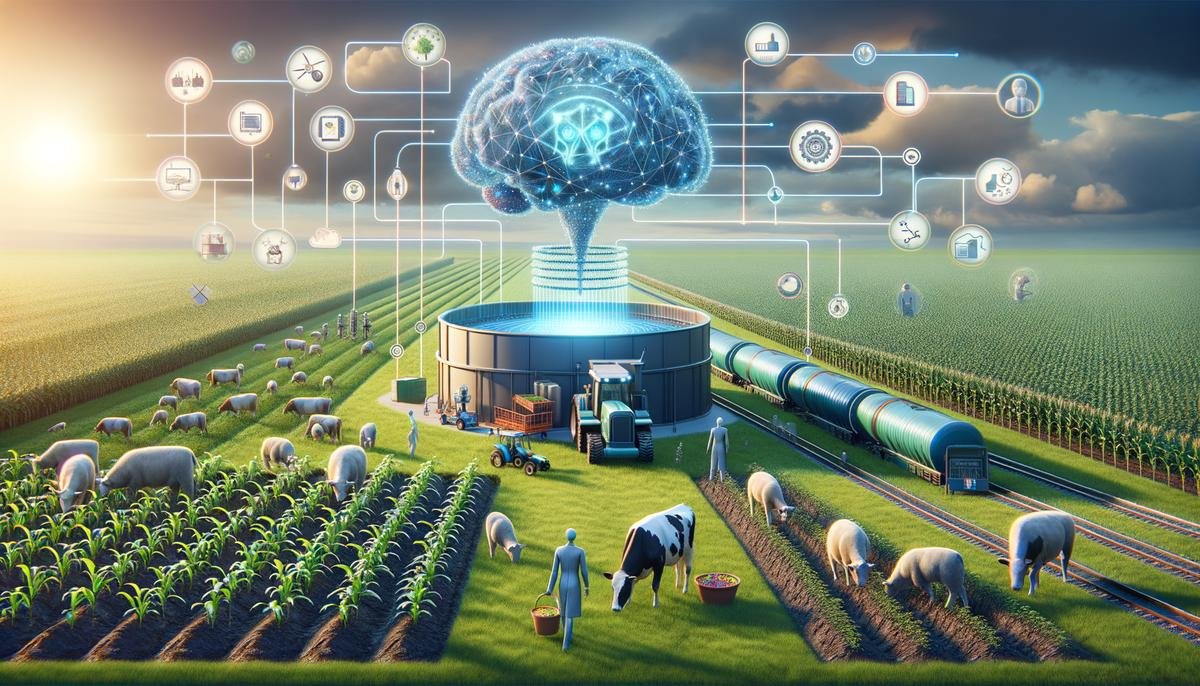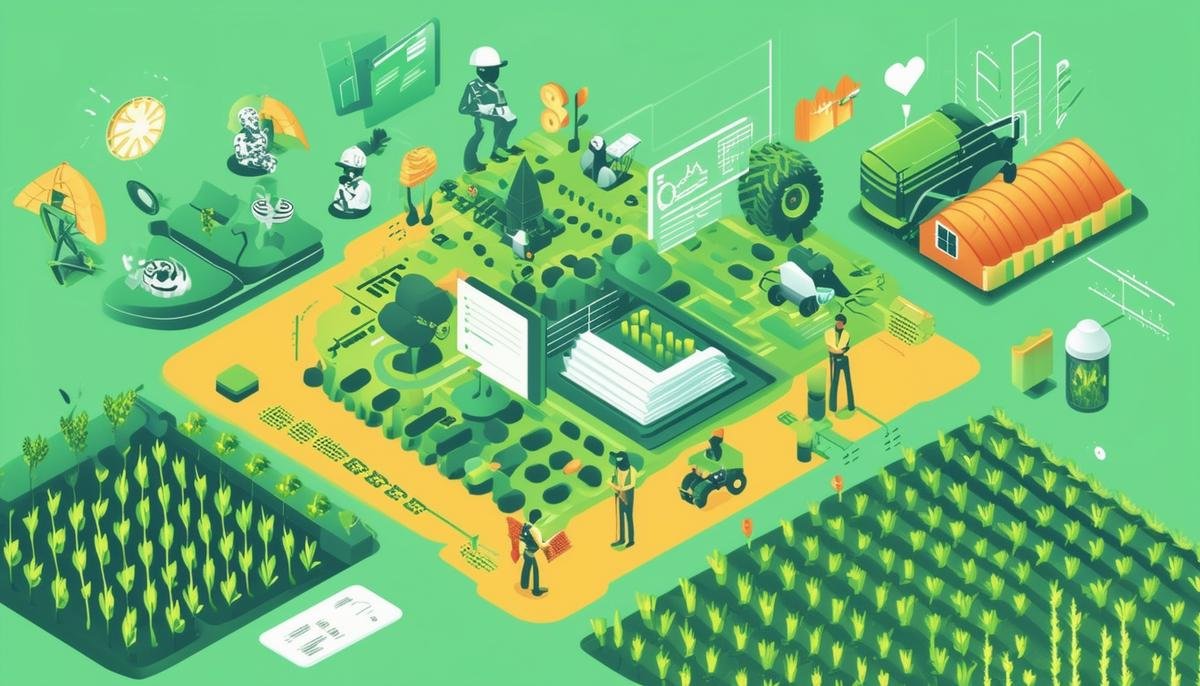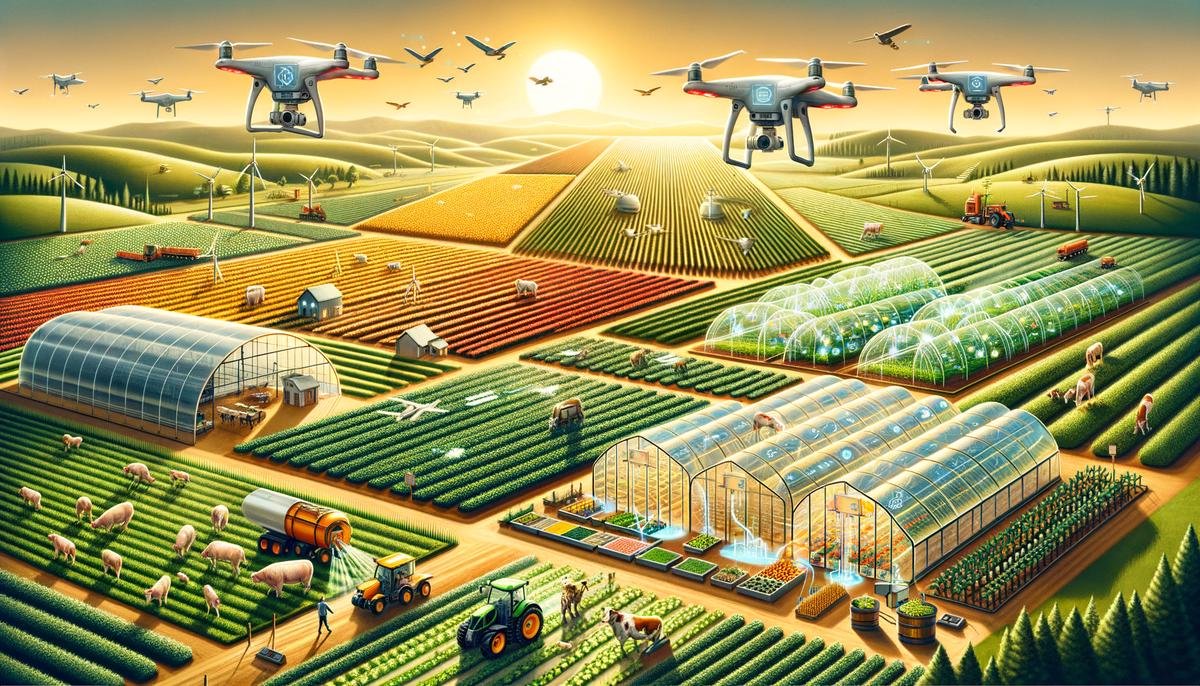Understanding AGI and Its Role in Agriculture
Artificial General Intelligence, or AGI, learns and adapts across various domains without human intervention. AGI is like a Swiss Army knife in agriculture, capable of addressing diverse farming challenges from soil to livestock management. It can transfer knowledge and skills across different agricultural fields, using past learning experiences to handle new situations and improve processes like crop monitoring and livestock health management.
AGI enables precision farming by optimizing resources like fertilizer and water use. It combines data from satellite imagery, drone imaging, and soil sensors to provide real-time insights on crop health and soil conditions, leading to more informed decisions and increased productivity.
However, implementing AGI in agriculture faces challenges. Quality data is crucial, and farmers in regions with limited connectivity may struggle to access accurate data. Ethical considerations like data privacy and job displacement also arise, requiring robust regulatory frameworks. The initial costs of AGI technology can be a barrier, especially for farmers with limited resources.
AGI’s potential extends to various agricultural use cases, such as robotics, phenomics, precision livestock farming, infrastructure management, disease detection, and predictive analytics. It doesn’t replace existing technology but works alongside it, like the AI in agriculture market valued at $608.5 million in 2022 with a projected growth rate of 25.2% from 2023 to 2029.
Despite its enormous potential, the journey to fully autonomous and adaptable systems is still evolving. Challenges need addressing to maximize AGI’s benefits in agriculture, and the sector must work closely with AI experts and policymakers to strive for productivity, sustainability, and resilience.
Precision Farming with AGI
AGI’s role in planting operations is transformative. It can analyze field-specific data to optimize planting strategies, adjusting planting patterns in real-time based on immediate field conditions. This ensures each seed is planted at the right depth and spacing, maximizing the chances of uniform germination and robust growth.
Irrigation benefits significantly from AGI, which integrates data from soil moisture sensors, weather forecasts, and satellite imagery to evaluate the precise water needs of different field sections. This allows for targeted irrigation, boosting crop health and productivity while conserving water.
Fertilization is another area where AGI shows immense potential. By analyzing real-time data from soil sensors, AGI can determine the specific nutrient requirements of different field zones, ensuring fertilizers are applied precisely where they’re needed in the exact amounts required. This improves crop growth and reduces the risk of nutrient runoff.
Pest control stands to gain from AGI’s predictive and analytical capabilities. By examining patterns from historical pest data, weather conditions, and current crop health indicators, AGI can predict pest outbreaks before they occur and identify pest-infested areas through data inputs from drones and cameras with AI vision systems. This allows for targeted intervention, reducing the need for blanket pesticide applications and promoting natural pest control methods.
To reap these benefits, widespread adoption of AGI technology in agriculture is essential. This requires investment in infrastructure, training for farmers, and regulatory frameworks to address ethical and data privacy concerns. By embracing AGI in precision farming, the agricultural industry can navigate the intricacies of modern farming, meeting the global demand for food more efficiently and responsibly.
AGI in Crop and Livestock Management
In crop management, AGI’s continuous learning and adaptability offer profound benefits. These systems can identify subtle changes in crop health that might be invisible to the human eye, allowing for early intervention that can save entire fields from being compromised.
AGI’s predictive analytics play a crucial role in yield prediction. By analyzing historical yield data, current weather patterns, soil conditions, and plant health indicators, AGI can forecast crop yields with high precision, aiding in mitigating market risks and ensuring food security.
AGI optimizes livestock health and behavior by integrating data from various sensors and monitoring devices. Intelligent sensors can monitor:
- Feeding patterns
- Body temperature
- Movement
- Behavioral changes in livestock
This allows for early detection of health issues or stress in animals. This enables timely veterinary intervention, potentially saving livestock and reducing reliance on antibiotics.
AGI contributes to resource optimization in livestock management by integrating data on feed quality, consumption rates, and growth patterns to optimize feeding strategies. This minimizes waste and reduces costs associated with overfeeding or underfeeding.
One powerful example of AGI in livestock management is its use in the dairy industry, where AGI systems can analyze data from automated milking systems to detect early signs of mastitis and alert farmers to take preventive measures.1

Challenges and Ethical Considerations
Implementing AGI in agriculture is not without significant challenges. Data quality and accessibility are crucial for AGI to function effectively. Farmers in regions lacking robust internet connectivity or technological infrastructure struggle to access and compile comprehensive, accurate data, hampering AGI’s efficacy.
The initial investment required for AGI technology poses another substantial barrier, especially for small-scale farmers with limited resources. The operational costs, including maintenance and software updates, must also be factored in.
Technical expertise is another crucial factor in the successful deployment of AGI in agriculture. The complexity of AGI systems necessitates a high level of technical knowledge for installation, operation, and maintenance, and training programs are vital to bridge this knowledge gap.
Ethical considerations are paramount, such as data privacy and algorithmic biases. Safeguarding data against breaches and ensuring its ethical use is crucial. AGI systems are only as unbiased as the data on which they are trained, and diverse and representative data sets, along with regular audits, are essential to mitigate biases.
The potential displacement of agricultural jobs due to automation is another ethical issue. It’s crucial to balance technological progress with socio-economic considerations, ensuring that those affected by automation have access to retraining programs and employment opportunities.
In conclusion, the path to integrating AGI into agriculture is laden with challenges and ethical considerations that must be conscientiously addressed. Through collaborative efforts among AI experts, farmers, and policymakers, the agriculture sector can responsibly adopt AGI, driving productivity and sustainability while upholding ethical principles.

Case Studies and Real-World Applications
One notable example of AGI’s successful implementation in agriculture is the use of AGI-enabled drones for crop monitoring in large-scale farming operations. Farmers in the Midwest United States have adopted AGI-powered drones to conduct comprehensive aerial surveys of their fields. These drones are equipped with advanced imaging sensors and AGI algorithms that can identify crop health and detect early signs of disease or pest infestations. By capturing high-resolution images, the AGI systems analyze the data in real-time, allowing for immediate agricultural interventions.
In one case study, a corn farming cooperative integrated AGI drones to manage their extensive plantations effectively. The drones enabled the farmers to pinpoint localized issues, such as nutrient deficiencies and water stress, which might have gone unnoticed through traditional methods. This targeted intervention led to a reduction in crop losses, improving overall yields by 15%. The optimized use of fertilizers and pesticides minimized environmental impact, conserving resources while maintaining crop health.
Another compelling case involves the automation of greenhouses with AGI systems in the Netherlands. These greenhouses use AGI to control the growing environment dynamically. AGI algorithms monitor data from various sensors tracking temperature, humidity, light intensity, and soil moisture levels. By continuously analyzing these parameters, the AGI systems adjust the greenhouse conditions to optimize plant growth. The result is a boost in productivity:
- Greenhouses reported a 20% increase in vegetable yields
- A 30% reduction in water and nutrient usage
This translates to more efficient resource management and higher quality produce, demonstrating the tangible benefits of AGI in controlled environment agriculture.
In Australia, AGI technology has been integrated into precision livestock farming to monitor cattle herds across vast ranches. Intelligent sensors on the animals, combined with AGI algorithms, track health indicators, movement patterns, and feeding behaviors. In one instance, a cattle rancher used AGI to monitor a herd of 2,000 cattle. The AGI system detected early signs of an outbreak of respiratory illness, allowing for prompt medical intervention.1 This early detection saved the lives of numerous cattle and reduced the spread of disease, leading to savings in veterinary costs and bolstering the overall health and productivity of the herd.
Precision irrigation, enhanced by AGI, is making strides in water-scarce regions like California. Vineyards adopting AGI-powered irrigation systems have experienced improvements in water use efficiency. The AGI systems integrate data from weather forecasts, soil moisture sensors, and satellite imagery to determine the exact water requirements for different vineyard sections. One vineyard reported a 25% reduction in water usage while maintaining, and in some cases improving, grape quality and yield.2 The AGI-driven approach ensures optimal water distribution, conserving this precious resource and enhancing the sustainability of water-intensive crops.
In India, smallholder farmers are benefiting from AGI-enhanced mobile applications that provide real-time agricultural advice. These applications utilize AGI to analyze data from local weather stations, soil sensors, and satellite imagery, offering personalized recommendations on crop management. Farmers receive guidance on when to sow, irrigate, apply fertilizers, and manage pests based on the specific conditions of their land. According to a pilot project in Maharashtra, this technology has led to a 10-15% increase in crop yields for participating farmers, showcasing how AGI can empower even small-scale agricultural operations with advanced, data-driven decision-making.
These real-world applications illustrate AGI’s potential across various agricultural domains. By automating tasks, providing real-time insights, and optimizing resource use, AGI addresses both productivity and sustainability.

Integrating AGI into agriculture offers significant potential for enhancing productivity and sustainability. By addressing challenges and ethical considerations, the agricultural sector can responsibly adopt AGI, leading to healthier crops, productive livestock, and a more sustainable future.




